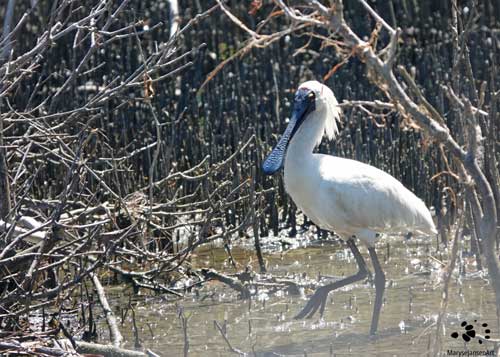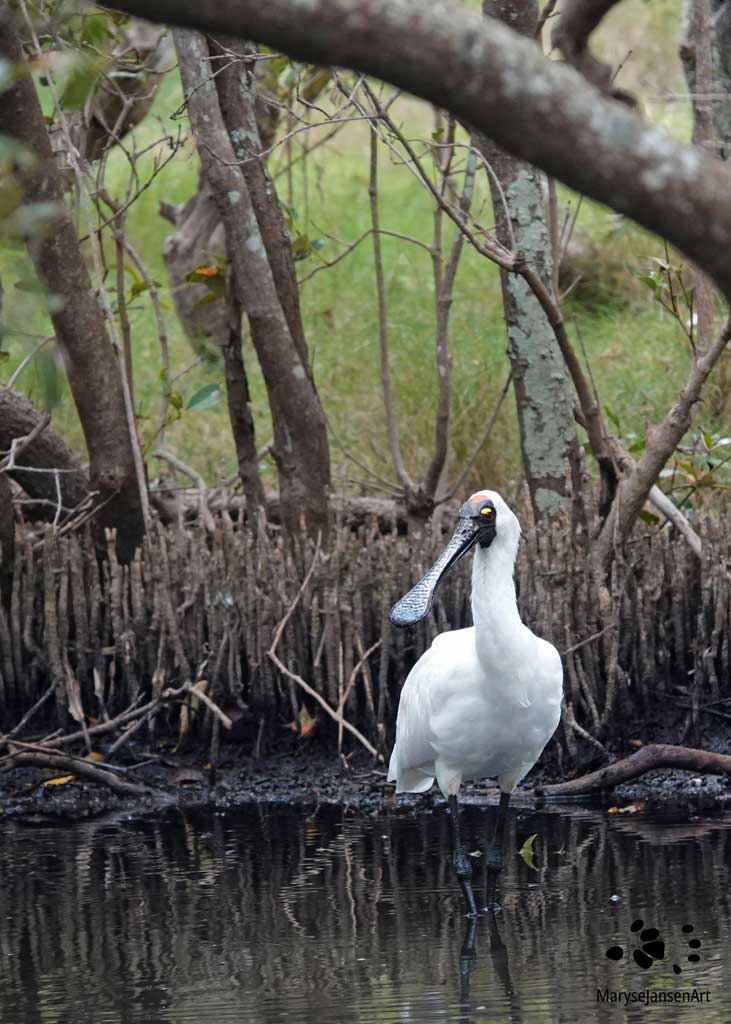Bird Photography with marysejansenart
Sweeping a Spoon-shaped Bill through Shallow Wetlands

Table of Contents
Royal Spoonbill – an applicable name
Gently finding its way between the pencil roots of the Grey Mangroves I spot a large, majestic looking bird. It is predominantly white and it has a dark, large bill with a very interesting shape! It resembles a spoon! No wonder this bird is called a spoonbill! And suiting its majestic appearance, this particular species is called the Royal Spoonbill!
The bird has black facial skin with golden-yellow markings that look like eyebrows. There is a red patch in the middle of its forehead and the eyes are red as well. The legs and feet are black. The amazing looking bill is black and dark blue and has an interesting texture which looks like wavy ridges. The shape looks like a flattened spoon and it’s often referred to as spatulate.
The spoon-shaped bill is a feeding tool
The reason the bill is shaped this way is that it is a tool that helps it find its food. The Royal Spoonbill feeds on fish, shrimps, other crustaceans and aquatic insects in shallow waters. It is most often seen slowly sweeping its bill through the water from side to side, while it holds their bill slightly open. On the inside of the spoon the bird has papillae, which are vibration detectors, with which it finds its prey. When the prey is caught, the bird lifts its bill and the food slides down its throat.
Other hunting techniques may be observed. Sometimes the bird will sweep really fast while walking at a quick pace or even running. It may also drag prey, probe it or grab it directly. Thanks to the papillae, it can find its prey easily in the murky waters of the mangroves or the many other shallow wetlands it inhabits. These include freshwater swamps and wetlands, as well as saltwater and brackish coastal wetlands. It also enables them to feed both during the day and the night.
The one I’m looking at is having a rest, feet in the shallow waters, you can see it in the featured image of this post. Due to its feeding techniques the Royal Spoonbill can only hunt in waters up to 40 cm deep and the bottom has to be soft (clay, sand or mud).
Breeding Plumes and Breeding Habits
I remember another time I spotted one. It was also in the mangroves, but in another location. That bird was on the hunt, and it did so at a quick pace. It also had white plumes forming a crest at the back of its head and neck. This meant it was in breeding plumage! You can see it in the image below.

During the breeding season the bird will find a mate to form a monogamous pair with. The Royal Spoonbill builds its nest up in the crown of a tree over the water or among high reeds and rushes. The nest consists of a shallow bowl or platform of sticks and twigs, lined with soft vegetation. While the male bird gathers the materials, the female bird weaves them together. They are happy to share the breeding grounds with birds of their own species as well as other waterbirds, including cormorants, herons, ibises and Yellow Spoonbills, but a pair may also nest in isolation.
Royal Spoonbills have been known not to be very tolerant of disturbances, especially when breeding, so to avoid them leaving their nests it is best to keep away. If all is well, 2-4 eggs are laid and these are incubated by both parents which takes about a month. Around 7 weeks later, the chicks fledge. They stick around for a while though, while both parents still feed them.
Distribution
The Royal Spoonbill is found widespread throughout a large part of Australia. It is fairly common in the northern and eastern half, and may also be seen in certain places along the west coast of Western Australia and in Tasmania. Coastal Royal Spoonbills are sedentary, while inland birds move around more depending on the availability of water.
The latest episode of ‘Come for a walk in the Australian Bush’ was taken on my recent walk in the tropical wetlands, where I spotted two Royal Spoonbills, sharing their feeding grounds with an Eastern Great Egret.
If you are interested in purchasing a print of the featured image ‘Royal Spoonbill Illuminates Mangrove Forest‘ or would like to see what the image looks like on the various merchandise products, please head to my shop. If you prefer ‘Meet the Royal Spoonbill‘, click here.


